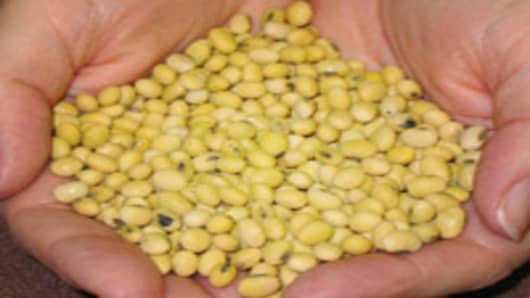Soft commodities have been on something of a rollercoaster over the past 6 months, with wheat and - to a lesser extent - corn bearing the brunt. The market expects strong forecasts this year with corn plantings predicted to reach their highest level since 1944.
But as we wave goodbye to a volatile first quarter, analysts believe soybeans are now a good bet thanks to strong demand in Asia.
“China is one of the biggest players. They have approximately 400 million hogs compared to the USA which has 64 million. These need to be fed and they feed them with soybeans. So the soybean market is going to be a big driver in the medium to long term," Erkut Ozer, CEO of Global Trading Enterprises told CNBC.
Luke Chandler, Global Head, Agri Commodity Markets Research at Rabobank, also sees strong potential in soybeans.
In first quarter of 2012 soybeans rose more than 13 percent on a continuation chart, marking the biggest quarterly gain in a year.
"In our 2012 outlook that we released in December, soybean meal and soybeans was our top pick and that’s really played out in this first quarter," Chandler said. "We were really factoring in the linear weather conditions and the downward productions for South American production and that’s certainly come to fruition."
Chandler predicts that the USDA and other government agencies will continue to downgrade production expectations in South America, thus placing a greater demand on the U.S. farmer to plant more soybeans.
He suspects that South America’s crop loss has yet to be fully priced in to the market.
"As a result we’ve seen soybeans rallying really hard over corn over the past few weeks to capture as much acreage as they can for this season’s crop because otherwise we’re going to see a very tight global soybean balance sheet for 2012 and ‘13," Chandler said.
Ozer believes we will now see a move towards different trends in growing, as farmers adapt to changes in population and climate.
“We’re seeing yields in the crops that we’ve never seen before and that’s down to genetically modified crops. Europe don’t import genetically modified crops, so essentially we’ve got Europe providing for itself,” he said.
“The crops aren’t as highly yielded and of the same quality, so we’ve got a disparity there. Eventually the euro zone will probably look to start introducing some of the genetically modified crops,” Ozer added.
He believes investors should take a "wait and see" approach when it comes to investing in soybeans.
“Everyone’s been liquidating, especially in corn,” he said.
“The soybeans have been following a little, but it’s still very high. We’re also expecting the largest ending stocks for a while in wheat. Maybe just wait a little while and buy on the dips,” said Ozer.


